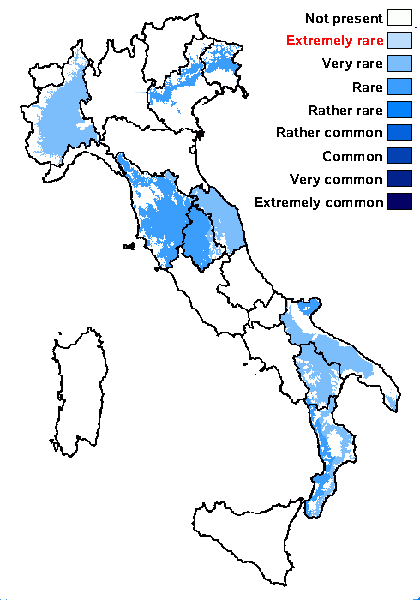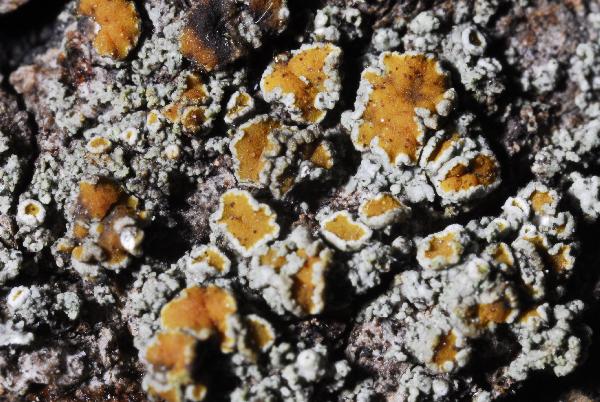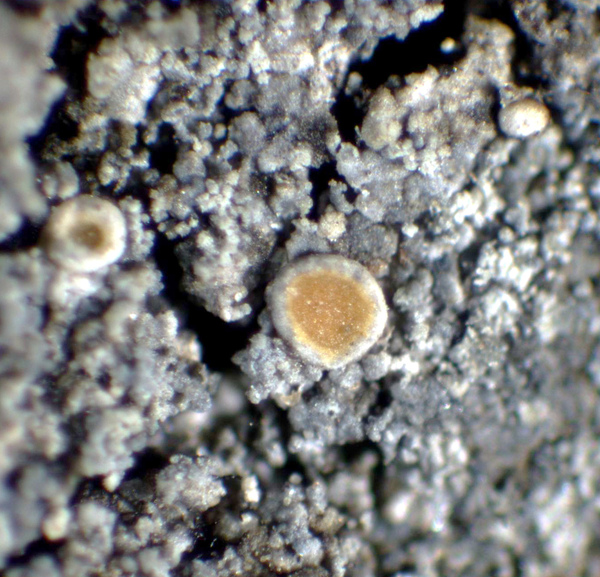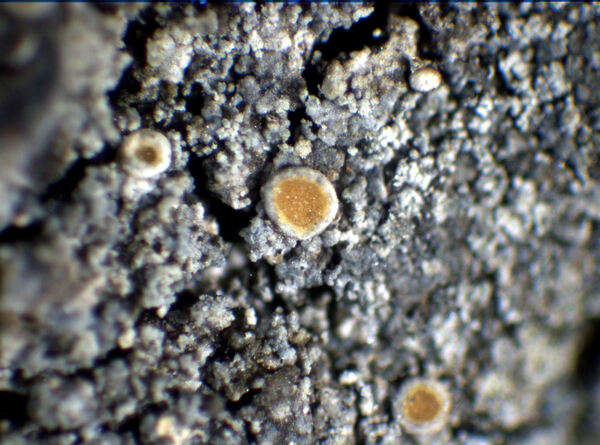Caloplaca turkuensis (Vain.) Zahlbr.
Cat. Lich. Univ., 8: 589, 1932. Basionym: Placodium turkuense Vain. - Ann. bot. Soc. Zool.-Bot. fenn. Vanamo, 6: 320, 1929.
Synonyms: Caloplaca virescens (Sm.) Coppins; Lepraria virescens Sm.
Distribution: N - Frl (LD-1048288), Ven (Nascimbene & al. 2021), Piem (TSB 33528). C - Tosc (Tretiach & Nimis 1994, Benesperi 2011), Marc (Nimis & Tretiach 1999, Frati & Brunialti 2006), Umb (Ravera & al. 2006b). S - Pugl (Nimis & Tretiach 1999), Bas (Nimis & Tretiach 1999), Cal (Puntillo & Puntillo 2004, Lich. Ital. Exs. 10: Puntillo & al. 2017).
Description: Thallus crustose, episubstratic, areolate, sorediate, up to several cm wide, up to 0.13(-0.3) mm thick, sordid white to pale grey, the areoles small, at first convex but later flat, up to 0.2 mm wide, usually very soon entirely sorediate. Soralia pale to dark grey or greenish grey with a bluish tinge, whitish or greenish inside, scattered to confluent, slightly convex; soredia 15-30 µm in diam. Cortex up to 10(-20) µm thick, paraplectenchymatous; medulla poorly developed. Apothecia lecanorine, abundant to absent, up to 0.8 mm across, sessile, with a flat to slightly convex, yellow-orange, usually epruinose disc, and a grey, often sorediate thalline margin. Thalline exciple 50-85 µm thick; proper exciple poorly evident, up to 15 µm thick, prosoplectenchymatous; epithecium orange, with granules, K+ purple-red; hymenium colourless, 55-100 µm high; paraphyses simple to branched, c. 2 µm thick at mid-level, the apical cells 3-5 µm wide; hypothecium colourless, sometimes inspersed with oil droplets, 55-110 µm high. Asci 8-spored, clavate, functionally unitunicate, apically thickened with a broad internal beak, the inner part of apex and external cap I+ blue, Teloschistes-type. Ascospores 2-celled, polarilocular, hyaline, ellipsoid, 10-15 x 6-9 µm, the equatorial thickening (“septum”) 4-6 µm. Pycnidia sometimes present, immersed, with an elevated, darker ostiole. Conidia bacilliform, 3-4 x c. 1 µm. Photobiont chlorococcoid. Spot tests: thallus K- or K+ violet (reaction best observed on thick sections under the microscope), C- or C+ violet, KC-, P-; disc of apothecia K+ purple-red. Chemistry: thallus with the Sedifolia-grey pigment; disc of apothecia with parietin (major), fallacinal, emodin, teloschistin and parietinic acid (minor). Note: a mild-temperate lichen found on old deciduous trees, especially oaks and chestnut, often near the base of the trunks, overlooked, or confused with C. cerina, but certainly not common. The species seems to be morphologically and ecologically close to C. monacensis, but differs in the well-developed, areolate, rarely fertile thallus with a thick layer of small granules, although molecular data suggest that it could be a sorediate-blastidiate morph of C. monacensis (Vondrák in litt.).
Growth form: Crustose
Substrata: bark
Photobiont: green algae other than Trentepohlia
Reproductive strategy: mainly asexual, by soredia, or soredia-like structures (e.g. blastidia)
Most common in areas with a humid-warm climate (e.g. most of Tyrrenian Italy)
Commonnes-rarity: (info)
Alpine belt: absent
Subalpine belt: absent
Oromediterranean belt: absent
Montane belt: absent
Submediterranean belt: very rare
Padanian area: absent
Humid submediterranean belt: rare
Humid mediterranean belt: absent
Dry mediterranean belt: absent

Predictive model
Herbarium samples


Domenico Puntillo - CC BY-SA 4.0
Italy, Calabria, Loc. Lacone (Rende, Cosenza) m. 172 coord. 39°22'40'' - 16°13'40'' leg. D. Puntillo 08-10-2024 su scorza di Quercus pubescens, alla base dell'albero.
Growth form: Crustose
Substrata: bark
Photobiont: green algae other than Trentepohlia
Reproductive strategy: mainly asexual, by soredia, or soredia-like structures (e.g. blastidia)
Most common in areas with a humid-warm climate (e.g. most of Tyrrenian Italy)
Commonnes-rarity: (info)
Alpine belt: absent
Subalpine belt: absent
Oromediterranean belt: absent
Montane belt: absent
Submediterranean belt: very rare
Padanian area: absent
Humid submediterranean belt: rare
Humid mediterranean belt: absent
Dry mediterranean belt: absent

Predictive model
| Herbarium samples |


 INDEX FUNGORUM
INDEX FUNGORUM
 GBIF
GBIF
 DOLICHENS
DOLICHENS




